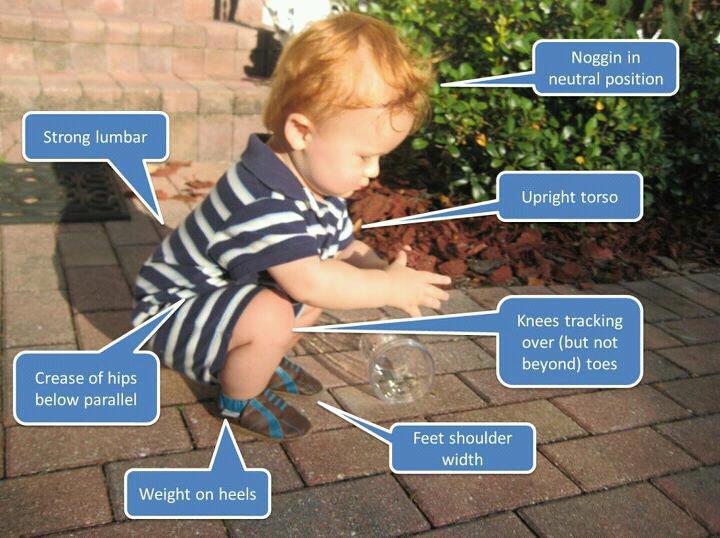Squats all the way down?
Replies
-
I used to work out under the supervision of professionals, and they all said the same thing. Going past a 90 degree bend puts a lot of strain on the ligaments between the muscles and the knee join and can lead to tears in the ACL, whcih is extrememly painful and difficult to heal. I would recommend not going past 90 degrees unless under the direct supervision of a professional who says otherwise (and by professional, I'm more referring to a physical therapist or sports medicine professional than a standard gym trainer).0
-
If I hurt my knees I'm basically on the sideline for all types of exercises for weeks, if not months, I'm not willing to take that risk. So I'd rather go heavier, then go lower.0
-
Now, as a pediatrician, I think I can weigh in on this photograph and say that this young child not only has excellent deep squat form, but is displaying age and developmental stage-appropriate manual and exploratory skills, though it appears what is in his hands may shortly go in to his mouth. Which I don't generally recommend with the bar at the gym.0
-
I can't go all the way down, but go past 90. I find if I only go to a seated postion I use my knees more to straighten up which hurts after a while. If I go lower I tend to use power in my thighs to go up. Just my experience anyway.0
-
Maybe this will help: http://www.biomechfit.com/2012/02/09/3-squatting-myths-that-refuse-to-die
Thanks for sharing this. That is a great article. To the OP, I would politely thank the gentleman for his well intentioned advice and continue doing your workout as you have been. Just listen to your body. Most of the issues I have seen and heard people attribute to squats are really related to going too heavy too soon and having poor form as a result. (Yes ... I am guilty of doing that to in my younger days and have paid the price!) You sound like you know what you are doing and are using good form, so I don't think you have anything to worry about.0 -
Lol that picture is awesome - never noticed kids definitely have perfect squat form0
-
He is right. The 90 degrees is the classic yoga 'chair' pose which really works out all the muscles involved, upper/lower belly, sides, thighs, calves. Going lower doesn't really help, except perhaps as cardio. I would say give both a trial and whichever works the largest group of muscles, go for it.0
-
i go to 90 degrees, but i see crossfitters going @$$ to the grass so i think there are multiple ways to do them.0
-
I read an article several months ago in the Journal of Strength and Conditioning where they weighed the pros and cons of going past parallel. I don't have it on me now since it was book form and not online. However, the conclusion they came to was that there is no added value to going past parallel. There are actually more injury risks to stopping before parallel, though.
So, while they didn't say you are setting yourself up for injury by going extremely deep on squats, they couldn't find any additional benefit from it.0 -
thanks everyone! I think I will keep doing deep squats with weight progression until I feel any kind of pain or strain on my knees. Then I will readjust and not go as low0
-
going lower gives more activation of glutes and hamstrings.0
-
Everything I have been told is to watch your knees in these types of exercises to prevent injury. I would say you are probably straining your knees both on the way down and up if you go beyond 90 degress. Those knee ligaments are very sensitive to that motion and could lead to long term damage. I suggest slightly tilt your toes outward and make sure you get your knees over your toes, that should be proper form for a perfect workout. Hope this helps!0
-
It is hard on the knees to go all the way down. My trainer only had me go at 90 degrees. If you are able to go down that low, I have to wonder if you don't need more weights, bc it is too easy for you. My trainer had my weights so heavy, I couldn't go past 90 degrees. I believe this is what is appropriate. I think the fact that you know this man's profession is irrelevant. He is probably just a man who knows something about working out and wanted to help you.
All the videos I have at home say to never go past 90 degrees bc it puts stress on the knees, Jillian Michaels is one, P90X guy is another, Denise Austin a third. All my instructors in classes at the gym is another that says that. Proper form is VERY important. You have to wonder if you lose momentum when you go that low. You get results when you are stressing the right muscles.0 -
He's wrong and should really mind his own business at the gym. I can't stand unsolicited advice when I'm working out!
I think you should squat as deeply as you can without feeling pain. Deep ATG squats have only been good for me--I've had knee trouble on my left side all my life, but ATG squats don't hurt at all, and I believe they're actually helping with strengthening and such.0 -
thank you for asking this question and thank you for the answers :flowerforyou:
I do *ss to grass squats, and I recently heard this from someone, and it was on my list of things to do to find out if it was true (in the meantime I continued squatting *ss to grass. Nice to know that there's no reason not to.0 -
I've been doing "deep squats" at the gym where I go all the way down until my butt almost hits the ground. I had an anesthesiologist come up to me at the gym yesterday and tell me never to go down farther than 90 degrees because of risk of injury and nothing more is done after 90 degrees anyways.
Is there any truth to this? I kind of feel stupid if I've been doing it wrong this whole time. I just thought deep squats were better for my gluteal muscles
The lower I go the more my *kitten* hurts the next day. So it must work the glutes. Usually people say don't go that low cuz they're jealous that you can and they can't.0 -
It doesn't matter how deep you squat. What matters is your form. When your knees go over your toes or farther forward, you risk injury. As long as your knees are over your heels, you're probably okay. It gets harder to maintain that correct form when you go deeper than 90 degree bend, but it's still possible.0
-
Please remember:

Funny...just the other day I was noticing that my toddler had perfect form without even trying. I actually ran and got my wife to show her as he was just squatting and playing with something. Then he pushed up and ran over to grab one of his tonka trucks...guess what? Perfect dead-lift form as well. It was awesome. I wonder where we all eventually go wrong and develop bad form since it's obviously so very natural.
I personally am not flexible enough to go much past parallel though.0 -
Drop it like it's hot!0
-
going lower takes pressure OFF of the knees and helps to insure strength balance between quads and hamstrings which also helps prevent knee injury.0
-
Please remember:

Funny...just the other day I was noticing that my toddler had perfect form without even trying. I actually ran and got my wife to show her as he was just squatting and playing with something. Then he pushed up and ran over to grab one of his tonka trucks...guess what? Perfect dead-lift form as well. It was awesome. I wonder where we all eventually go wrong and develop bad form since it's obviously so very natural.
I think being too sedentary weakens the legs, then you can't do those movements correctly because you lack strength. Also, social conditioning affects people, I'm not sure about boys/men, but plenty of women are conditioned into being more "dainty" and "feminine" in how they move... the correct form for squats and deadlifts is not dainty or feminine (by conventional standards of feminine, which I, personally, don't subscribe to, but it's what people get conditioned into being like)0 -
Please remember:

Exactly.
This is true -- but look closely. The knees are OUT (not straight in front, knee over ankle, like we're sometimes told to do). That's also why primitive people who eat, work, and relax in this position have NO knee or back issues like we do.
BUT, If you squat deep, you have to get the knees out.
The problem is that most fitness instructors are taught that knees must stay straight, and CANNOT go past the toes. You even get points off in certifications for anything different from this. And yes, if you try to go below 90 degrees with the knees straight ahead, it's a LOT of pressure on the knees, and the risk of injury goes WAY WAY up.
HOWEVER, squatting with the knees APART is much much safer. (But they never teach you this in traditional trainings). This is how weightlifters squat with a lot of weight on their bodies, and there is actually a lot LESS pressure on the knees as you go deep. The most pressure is exerted (if I remember correctly) at the bottom of the squat, but just for a second. The rest of the time pressure is evenly distributed through your legs, making it SAFER.
Hope this helps!0 -
We all go wrong from sitting around all day shortening our hams and calves. Don't let your babies use chairs; they'll thank you when they're 80.

If your form is good, keep it up - but as you increase weight, keeping your knees plumb over your ankles becomes more important (well, I guess all aspects of the form become more important). If you track forward a lot, even if you don't go past your toes, maybe practice not doing that as much before you start hauling up 300 pound weights.
She said, pretending to be an expert.0 -
I have actually looked into this because I had knee surgery, an ACL repair, this year. I read everything I could. It seems that there is no great harmful stress placed on the knees from squatting, generally. It is what they are designed to do -- to bend, that is. In fact, the further down you go the more your ACL, at least, is protected because your hams and your glutes fire and come into play, and hold the knee joints together in the places they are supposed to be held.
At least, according to the research, your anesthesiologist is wrong.0 -
He is right. The 90 degrees is the classic yoga 'chair' pose which really works out all the muscles involved, upper/lower belly, sides, thighs, calves. Going lower doesn't really help, except perhaps as cardio. I would say give both a trial and whichever works the largest group of muscles, go for it.
I believe this is wrong too: Going lower does help. You engage your glutes and hams more once you get down below 90, and that is a good thing. When you squat, you are supposed to go "into the hole." It makes for a much better exercise.0 -
90 degrees is actually the point of least tension, between flex and extension. The full range of motion (loaded or not) would be all the way up and all the way down. Of course, caution is important not to overload your joints. Ask a physical therapist their thoughts if you want someone who understand biomechanics and can help.0
-
It doesn't matter how deep you squat. What matters is your form. When your knees go over your toes or farther forward, you risk injury. As long as your knees are over your heels, you're probably okay. It gets harder to maintain that correct form when you go deeper than 90 degree bend, but it's still possible.
This is not true. Look at children when they squat down, we all would have blown our knees out before six years old.
Edit: I did not see that someone else had covered this point.0 -
It doesn't matter how deep you squat. What matters is your form. When your knees go over your toes or farther forward, you risk injury. As long as your knees are over your heels, you're probably okay. It gets harder to maintain that correct form when you go deeper than 90 degree bend, but it's still possible.
This is not true. Look at children when they squat down, we all would have blown our knees out before six years old.
Edit: I did not see that someone else had covered this point.
Agreed. Not only is keeping your knees over your heels wrong, it's also physically impossible. Try it right now with no weight. If you keep your knees over your ankles, you will fall over backwards at about 5 degrees of knee bend.0 -
I've always done squats ATG, which feels to me the most natural way to do them. I just, for an experiment, tried doing bodyweight squats only to 90 degrees. And it hurt my knees. Not bad pain, just a twinge, but enough to make me want to stick to ATG squats which feel totally comfortable and natural.0
-
IIRC for an Olympic squat to count you must go past parallel. Power lifters stop at 90˚
I could be wrong on that. Maybe someone else can chime in on that point?0
This discussion has been closed.
Categories
- All Categories
- 1.4M Health, Wellness and Goals
- 398.2K Introduce Yourself
- 44.7K Getting Started
- 261K Health and Weight Loss
- 176.4K Food and Nutrition
- 47.7K Recipes
- 233K Fitness and Exercise
- 462 Sleep, Mindfulness and Overall Wellness
- 6.5K Goal: Maintaining Weight
- 8.7K Goal: Gaining Weight and Body Building
- 153.5K Motivation and Support
- 8.4K Challenges
- 1.4K Debate Club
- 96.5K Chit-Chat
- 2.6K Fun and Games
- 4.8K MyFitnessPal Information
- 12 News and Announcements
- 21 MyFitnessPal Academy
- 1.5K Feature Suggestions and Ideas
- 3.2K MyFitnessPal Tech Support Questions






















